NSKK Crash Helmet (2nd pattern)
CATEGORY: Version
SKU: 53.GOR.01.02.003.001
Estimated market value:
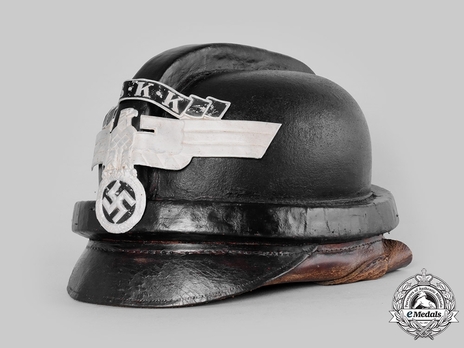
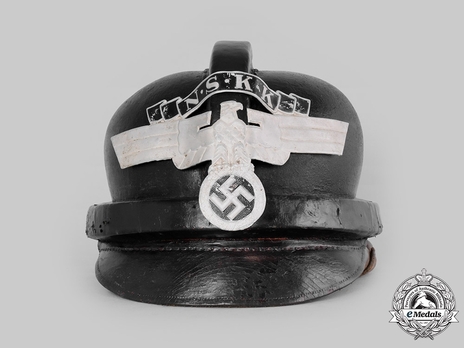
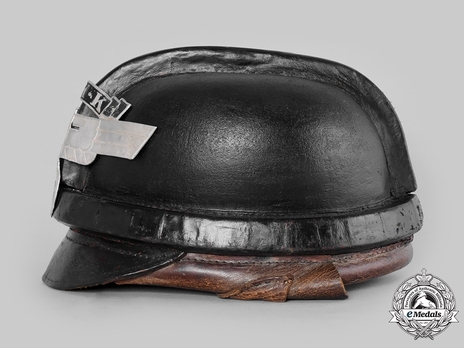
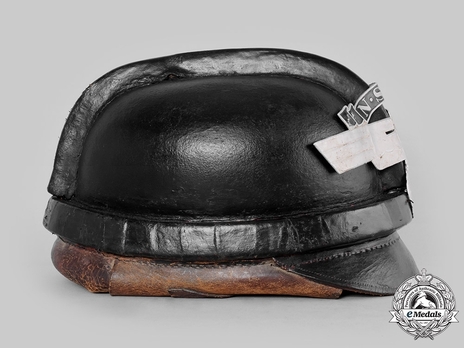
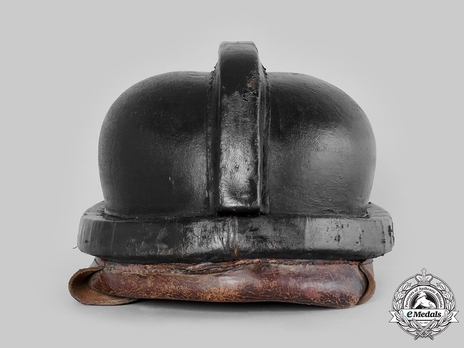
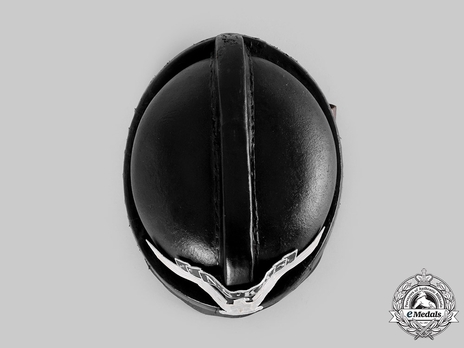
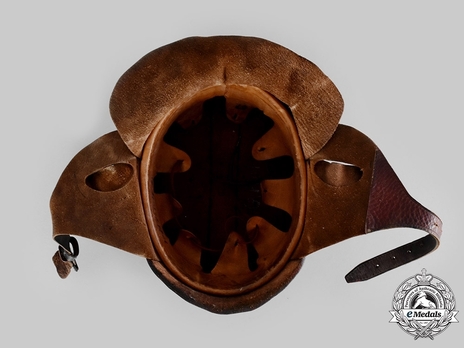
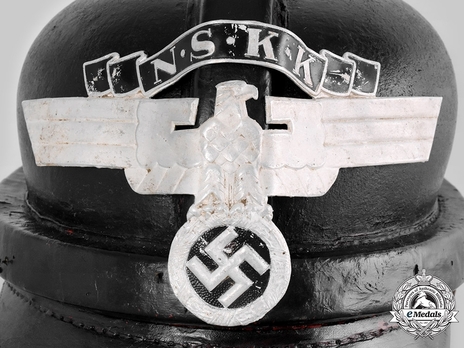
Estimated market value:
A very well-preserved National Socialist Motor Corps (NSKK) crash helmet, constructed of a boiled blackened leather shell. It bears protective reinforced leather bands, with one extending over the crown from front to back, and another around the rim of the helmet. The peak bears an aluminum insignia in the form of a second pattern NSKK-style German national eagle clutching a wreathed mobile swastika, topped by a banner bearing raised initials “NSKK” on a blackened background. The exterior features are completed by a protruding blackened leather frontal visor. The interior features a brown leather chinstrap, one end bearing a functional magnetic metal buckle, with the other end perforated by seven holes, allowing for an adjustable fit. Each chinstrap features additional leather crescent adornments with reverse slits, providing ear protection without compromising functionality. The reverse also bears a brown leather neck protector, which can be rolled back into the interior when not in use. A brown leather sweatband is securely held in place by machine stitching, bearing nine integrated fingers, each perforated with a hole through which is looped a drawstring. The interior crown bears a black ink maker’s mark of “BUSSE, MAINZ”, for the firm of Carl Busse, with a size stamp of “57”. Additionally, both the sweatband and crown bear a handwritten owner’s name of “G. HOLZAPFEL”. The helmet measures approximately 190 mm (w) x 250 mm (l) x 155 mm (h). Age-appropriate material fatigue is evident to the leather elements, and there is some oxidation of the eagle insignia. The helmet is in an overall better than very fine condition.
The NSKK (Nationalsozialistisches Kraftfahr-Korps = National Socialist Motor Corps) was a paramilitary organisation affiliated with the NSDAP, specialising in anything related to the driving of motorised vehicles. NSDAP officials recognised the need for access to cars and trucks for both transportation and propaganda purposes as early as 1922, and certain steps were taken to ensure this need was met. However, it took until April of 1930 for a specialised motor organisation to be officially founded. This organisation was named NSAK (Nationalsozialistisches Automobil-Korps = National Socialist Automobile Corps), but was renamed to NSKK less than 13 months later.
Initially, the NSAK/NSKK was under the control of the SA and existed next to its parent organisation’s own driving-related sub-organisation, the Motor-SA. This changed after the “Night of the Long Knives”, in which many SA leaders were purged and the organisation was substantially disempowered. After July of 1934, the NSKK became an independent organisation whose leader, NSKK-Korpsführer Adolf Hühnlein, answered directly to Adolf Hitler.
The main tasks of the NSKK were to provide transportation for all organisations of the Third Reich, to train and instruct boys and men (and a number of women) in mechanics and driving, and to assist police in regulating traffic. During the mid 1930s, the organisation also provided roadside assistance.
With the onset of the war, the NSKK’s tasks underwent certain changes. Instructing both civilians and soldiers in the driving and maintenance of armored vehicles became a higher priority. The NSKK also began working closely with other organisations, for example Organisation Todt (OT), by providing transportation of workers and supplies for the colossal building project that was the fortification of Germany’s Western border, the Siegfried Line (or Westwall). During the war, the NSKK provided much of the transportation needs for the German Army and the Luftwaffe, including the transport of troops, weapons and ammunition, and building materials, for example for the construction of air bases in the newly conquered territories in Eastern Europe after the attack on Soviet Russia in the summer of 1941.
Parts of the NSKK would come under the control of architect Albert Speer who took over OT after the death of Fritz Todt in 1942, leading to the creation of Transport Brigade Speer (later Transport Corps Speer), which would eventually completely sever its ties to the NSKK.
Members of the NSKK wore the same pattern of Crash Helmet as members of the Motor-SA, but with a different helmet badge. The visored helmets were produced out of leather that was 2.5-3 mm thick or vulcanised fibre that was around 1.5mm thick. Although the vulcanised fibre is thinner, it is a much stronger material. A protective tube-shaped layer of padding is attached to the lower edge helmet, as well as to the top of the helmet, spanning from the forehead area to the back. A protective leather flap covers the back of the head and features closeable ear flaps. A leather strap fastens under the wearer’s chin with a metal buckle.
The helmet was originally issued with an SA pattern helmet badge, which depicts a leftward facing eagle with outstretched wings. The eagle is clasping an enwreathed swastika in its talons. The badge is silver in colour, except for the swastika which is painted black.
The crash helmets were eventually issued with an NSKK pattern helmet badge, which features a leftward facing eagle with long, rectangular wings. The eagle claps a wreath with a cutout swastika in the centre. Above the eagle, there is a banner with the initials “N.S.K.K.”.
The crash helmet was worn while driving, and also at special events such as parades.
Some NSKK units that served in mountainous regions attached an Edelweiss insignia to the left side of their crash helmet.
There is a visorless NSKK helmet that was produced with vulcanised leather and without additional padding. The helmet simply features a leather chin strap, as well as a protective neck and ear covering. The front of this helmet features a decal of the NSKK insignia.

Comments
Sign in to comment and reply.


Scroll Top